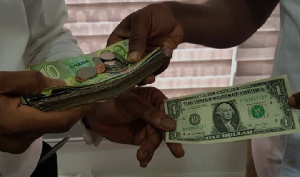I have been following the discussion of the current state of the Ghana cedi (Ghc) that has been raging on. I find the debate quit interesting to say the least. Many have contributed to the debate including the clergy. Reasons for the decline or “free-fall” as many prefer to describe it have been coined and some have even proposed solutions. I will like to attempt to shed some light on some aspect of the debate. However, I wish to remind readers that I am not writing this article to defend or chastise any government or individual.
In this article, I examined the above mentioned problem from a different angle. That is, to analyze the trend in the Ghanaian currency by studying data from five different countries over one year period. The reason why I am taking this approach is that, I would like to believe that the trend in the value of the Ghc has two components just like other currencies, that is, the exogenous and endogenous components. The focus here will be on the former and I would like to compare the trends in the Ghana cedi (Ghc), Norwegian Kroner (NOK), Nigeria Naira (NGN) and South Africa Rand (ZAK). I have also looked at the trend in the Canadian Dollar (CAD) for additional insight. The source of the data is http://www.ghanaweb.com/GhanaHomePage/economy/forex.php. I studied quarterly estimates of the US dollar against these five currencies by looking at data from the above source and then calculating the change from one quarter to the preceding one. In fact the choice of these currencies is partly arbitrary. Percent change (%) in parenthesis.
Date 01/04/2013 03/04/2013 06/04/2013 09/04/2013 12/04/2013 02/04/2014
Ghc 1.928(-) 1.934(0.5) 2.012(3.9) 2.177(8.6) 2.305((6.6) 2.409(5.4)
NOK 5.565(-) 5.757(3.5) 5.845(1.6) 6.080(4.2) 6,114(0.6) 6.277(2.9)
NGN 158.9(-) 160.3(0.9) 160.2(-0.1) 165.3(3.2) 158.9(-0.4) 164.3(3.4)
ZAK 8.537(-) 9.070(6.2) 9.981(1.1) 10.300(3.7) 10.320(0.2) 11.171(10)
The results show that all the above currencies have declined over the last 12-13 months against the USD. The Ghanaian cedi has clearly been declining since Jan. 2013 so were those of Norway and South Africa. A steady decline can be seen in the case of Ghana, Norway and South Africa. In the case of Nigerian Naira however, the trend has been cyclical. For instance, in June and December 2013 the Naira appreciated slightly but has again declined to around the September 2013 level in February 2014. The estimated decline in the Ghanaian cedi from the 4th of Jan. 2013 to the 4th of February 2014 is about 25 percent. Compared to the other three currencies the Ghc has done better than the South Africa ZAK that has suffered a whopping decline of 31% during this period. The Norwegian Kroner (decline 13%) and Nigerian Naira (3.4%) however both have done relatively better than the Ghc, the Naira being the most stable currency during this period. With regard to the CAD one can also see a clear downward trend. In Jan. 2013 the Canadian currency was stronger than the US dollar that is 1 CAD to 0.985 USD and by March the USD surpassed the former and the CAD has since been declining. From Jan. 4 2014 to Feb. 4 2014 the Canadian dollar fell by 4.5 percent.
It is worthwhile to note that the US dollar, the British pound and the Euro are more than just currencies in Ghana. They are in my view commodities or services that ought to be affected by inflation. The reason being that many peoples livelihood hinges upon remittances. For example there are many parents that depend on periodic fixed remittances of say 200 dollars from their children. With the near hyperinflation in the country these parents will tend to suffer if the exchange rate is independent of inflation. Many cannot afford to keep adjusting the amount they support dad and mom with in steps with inflation in Ghana. Of course many countries will adjust pension payments by the annual inflation in order to leave the quality of lives of the people relatively unchanged.
Conclusion: The USD has been appreciating against several other currencies across the globe. The Ghc is among the worst affected with significant decline that to some qualifies to be termed free-fall. The deepest decline is seen in the South African Rand, falling by ca 31% in the last year. The trend observed in Ghana is in part due to the exogenous or external component, that is, the USD gaining momentum in recent times. The Naira appears to have held on to its value much better than the other currencies. Now the question is, what is President Goodluck Jonathan doing with his economy? What is special about the Nigerian Naira? Perhaps President John Mahama needs to take some lessons from his counterpart.
Author Aminu Ussif
Opinions of Saturday, 8 February 2014
Columnist: Ussif, Aminu


















